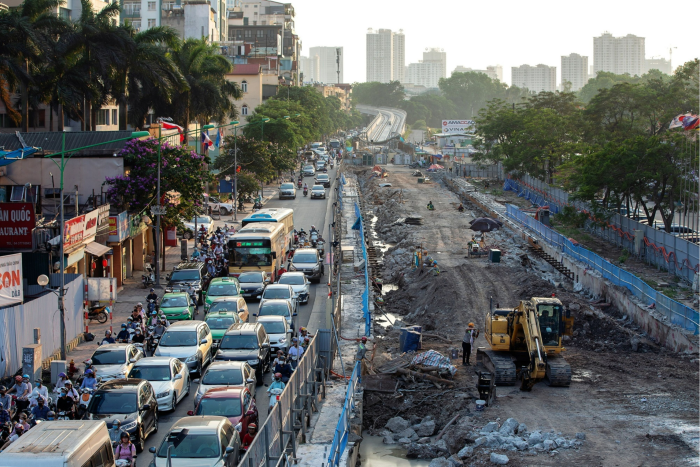Vietnam tops tech growth market index

Roula Khalaf, Editor of the FT, selects her favourite stories in this weekly newsletter.
Nick Lonsdale was struck by the number of mopeds that dominated the streets of Hanoi when he first visited just six years ago. “Now there are just so many cars,” says the chief executive of Nashtech, a British IT group which is the biggest foreign-owned technology employer in the country. “The prosperity is palpable.”
Over the next five years, a similar transformation will take place in the country’s tech sector. Vietnam’s digital economy is set for compound annual growth of 8.9 per cent between 2022 and 2026, the fastest of any of 51 countries surveyed in the FT-Omdia Digital Economies Index.
The country will experience breakneck expansion in connectivity and device penetration, for which it ranks first in the index, as well as strong growth in digital payments and entertainment. Analysts say that growth will be buoyed by the country’s young population, supportive government policies and an influx of foreign money and investors.
Mike Roberts, principal consultant at Omdia, a technology research firm, highlights the Vietnamese government’s policies, including its goal to reach full smartphone penetration by the end of next year and its 2025 digital transformation plan, which sets ambitious goals for upgrading the country’s records, public services and banking infrastructure.
Vietnam’s demography is another “fundamental driver” of growth in its digital economy, according to Roberts, with 70 per cent of its population of more than 98mn under the age of 35.

Meanwhile, literacy rates for people aged 15-24 reached 99 per cent in 2019, according to the most recent World Bank figures, making the country a prime market for mobile devices.
“There’s very strong [mobile] adoption in Vietnam and that’s going to continue,” Roberts says.
But he cautions that, while the government’s policies send a positive signal to investors, some of its targets are unrealistic.
“There is uncertainty in many countries, Vietnam included, around the extent to which government support will remain over time,” he says. “There’s a whole slew of very ambitious goals . . . some of which will be hit and some which won’t.”
Potential inhibitors of growth, he adds, are the country’s relatively low-income population and under-developed physical infrastructure, both of which could inhibit uptake of digital products.
“One [example] that comes to mind is Vietnam is growing like crazy in connectivity . . . but the actual speed of broadband services in the country can be relatively slow,” Roberts says, adding that the country has fewer undersea cables connecting it to the wider world than other south-east Asian countries. “[That] just means less bandwidth to share around.”
Even so, Vietnam is one of south-east Asia’s most important destinations for foreign direct investment, according to Omdia, especially for the manufacturing industry. This, it says, will help accelerate 5G data usage, as growing businesses start to rely on 5G’s fast, high-bandwidth connections to improve the running of cloud IT services and automation in factories.
The next tech growth markets

Countries to watch 2022-2026
Omdia predicts that Vietnam will have the world’s fastest-growing digital economy, with a weighted compound annual growth rate of 8.9 per cent between 2022 and 2026. The runners up, with their CAGRs, are:
2. India (8.7%) In terms of absolute size, India’s digital market is exceeded only by China and the US. Launching this year, 5G services are forecast to have 370mn subscribers, some 30 per cent of the mobile market, by 2026
3. Mexico (8.1%) Covid has delayed Mexico’s 5G rollout, which began only late last year, but Omdia forecasts that it will account for 42 per cent of mobile phone subscriptions by 2026
4. Indonesia (7.7%) Telecoms operators this year said they would speed the transition of 3G users to 4G. By 2025, Indonesia is predicted to overtake South Korea as the FT-Omdia index’s ninth biggest digital economy.
5. Israel (7.5%) Although Israel is one of the smaller digital economies in the index, its digital entertainment market has the highest CAGR for 2022-2026, at 12.3 per cent
Source: FT-Omdia Digital Economies Index
The country auctioned 5G spectrum for the first time in late 2021 and will reach 2.4mn subscribers by the end of this year following the launch of high-speed coverage by its three main carriers, Viettel, VNPT and MobiFone.
FDI inflows have also benefited from a flight of foreign capital from China as international investors are spooked by the country’s wide-ranging tech-sector crackdown and its strict zero-Covid policy, analysts say.
In August, Nikkei reported that Apple was in talks to start producing Apple Watches and Macbooks in Vietnam for the first time. That followed Apple shifting some of its iPad production to the country after a two-month lockdown in Shanghai disrupted supply chains earlier this year.
Dominic Scriven, chair and co-founder of Dragon Capital, a Vietnam-based investment group, says more companies are moving their regional headquarters to Ho Chi Minh City (formerly Saigon). “It’s not yet a global hub but definitely a trend — from Hong Kong and Shanghai,” he says.
Scriven adds that, while the country shares some similarities with China, including its Communist party-led political system, capital in Vietnam is significantly less centralised than it is in its northern neighbour and the younger population gives it a distinct demographic advantage.
“There’s still a great deal of optimism of becoming wealthy before you become old, which I think has been thrown out the window in China,” he says.
Nonetheless, he cautions, the economic struggles of the world’s second-largest economy, which remains Vietnam’s largest trading partner and a “very key relationship”, also create downside risks.
Vietnam’s exports fell just over 14 per cent between August and September, with slowdowns in western economies also likely to be a factor.
Consumer price inflation rose to 4.3 per cent year-on-year in October, up from 2.9 per cent as recently as August. While that remains significantly below the multi-decade highs seen in the western world, analysts say Vietnam’s rapid growth and reliance on fuel and food imports expose it to surging commodity prices in the wake of Russia’s invasion of Ukraine.
Yet the country’s tech ambitions remain intact. Nashtech’s Lonsdale says that, although the government “has its idiosyncrasies”, he has seen Vietnam press forward with digitising everything from banks and wealth services to healthcare and insurance in recent years.
“You’ve got people . . . who are just salivating with the opportunity,” he says.

Comments